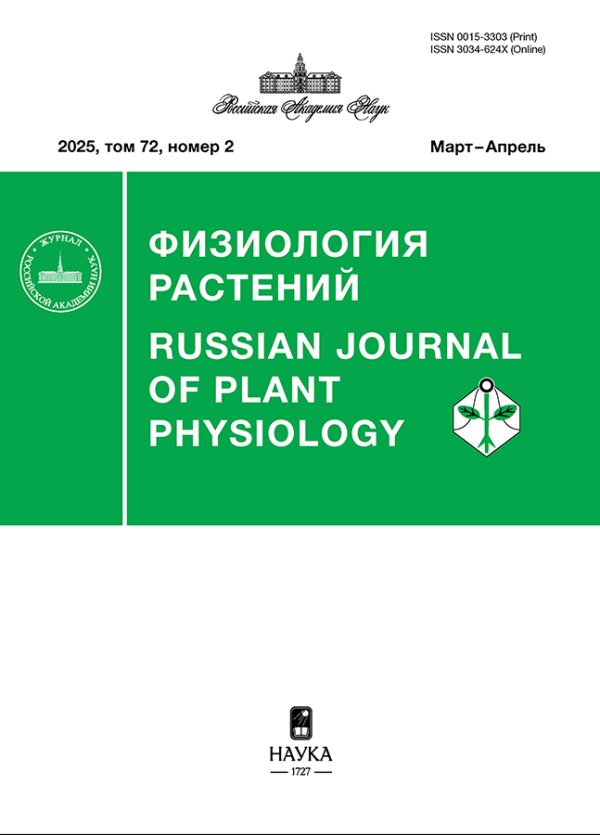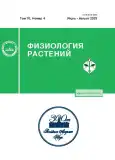Isolation of CP-PVY-Specific siRNA from PVY-Infected Plants of Solanum tuberosum
- Authors: Sutula M.Y.1, Kabataeva Z.K.1, Komekova G.K.1, Khosnutdinova T.S.1, Zhakmanova E.A.1
-
Affiliations:
- Non-commercial joint stock company “East Kazakhstan University named after Sarsen Amanzholov”
- Issue: Vol 70, No 4 (2023)
- Pages: 365-371
- Section: ЭКСПЕРИМЕНТАЛЬНЫЕ СТАТЬИ
- URL: https://journals.rcsi.science/0015-3303/article/view/139776
- DOI: https://doi.org/10.31857/S0015330322600711
- EDN: https://elibrary.ru/IBNXFM
- ID: 139776
Cite item
Full Text
Abstract
Tools for activating crop resistance to viruses are now becoming part of a comprehensive plant protection strategy. Artificial resistance to viruses through expression of the viral envelope protein in transgenic plants is fairly well understood. An urgent issue is the study of small RNAs involved in the protective mechanisms of RNA interference against viruses. Understanding the role of short interfering RNA (siRNA) in the regulation and shutdown of genes is important. The proteinase accessory component (HC-Pro), a multifunctional suppressor protein synthesized by the potato virus Y, is able to neutralize S. tuberosum plant defenses by trapping siRNA and removing them from the RNA interference process, thereby causing systemic infection of the host plant. Protein liquid chromatography combined with high performance sequencing can help recognize the large number of small RNAs resulting from viral RNA degradation and identify 21–23 bp. siRNA from PVY-infected S. tuberosum plants. The HC-Pro/siRNA nucleoprotein complex was detected in chromatographic fractions using antibodies against HC-Pro, Southern-blot indicated the presence of small RNAs in the complex, and analysis of data from deep sequencing of the small RNA population determined a specificity of 21–23 bp. siRNA to the envelope protein of the PVY virus. The research results can be applied in the study of intracellular signaling molecules and stimulate new research on antiviral mechanisms to develop effective strategies for plant protection against viruses.
Keywords
About the authors
M. Yu. Sutula
Non-commercial joint stock company “East Kazakhstan University named after Sarsen Amanzholov”
Email: max.sutula@gmail.com
Kazakhstan, Ust-Kamenogorsk
Zh. K. Kabataeva
Non-commercial joint stock company “East Kazakhstan University named after Sarsen Amanzholov”
Email: max.sutula@gmail.com
Kazakhstan, Ust-Kamenogorsk
G. K. Komekova
Non-commercial joint stock company “East Kazakhstan University named after Sarsen Amanzholov”
Email: max.sutula@gmail.com
Kazakhstan, Ust-Kamenogorsk
T. S. Khosnutdinova
Non-commercial joint stock company “East Kazakhstan University named after Sarsen Amanzholov”
Email: max.sutula@gmail.com
Kazakhstan, Ust-Kamenogorsk
E. A. Zhakmanova
Non-commercial joint stock company “East Kazakhstan University named after Sarsen Amanzholov”
Author for correspondence.
Email: max.sutula@gmail.com
Kazakhstan, Ust-Kamenogorsk
References
- Loebenstein G., Manadilova A. Virus and virus-like diseases of major crops in developing countries // Springer, Dordrecht, Netherlands. 2003. P. 195. https://doi.org/10.1007/978-94-007-0791-7_8
- Chikh-Ali M., Tran L.T., Price W.J., Karasev A.V. Effects of the age-related resistance to potato virus Y in potato on the systemic spread of the virus, incidence of the potato tuber necrotic ringspot disease, tuber yield, and translocation rates into progeny tubers // Plant Disease. 2020. V. 104. P. 269. https://doi.org/10.1094/PDIS-06-19-1201-RE
- Ghildiyal M., Zamore P.D. Small silencing RNAs: an expanding universe // Nat. Rev. Genet. 2009. V. 10. P. 94. https://doi.org/10.1038/nrg2504
- Bushra T., Idrees A.N., Usman A., Tayyab H. How RNA interference combat viruses in plants // Functional Genomics. 2012. V. 6. P. 113. https://doi.org/10.5772/51870
- Carthew R.W., Sontheimer E.J. Origins and mechanisms of miRNAs and siRNAs // Cell. 2009. V. 136. P. 642. https://doi.org/10.1016/j.cell.2009.01.035
- Dunoyer P., Himber C., Voinnet O. DICER-LIKE 4 is required for RNA interference and produces the 21-nucleotide small interfering RNA component of the plant cell-to-cell silencing signal // Nat. Genet. 2005. V. 37. P. 1356. https://doi.org/10.1038/ng1675
- Omarov R., Sparks K., Smith L., Zindovic J., Scholthof H.B. Biological relevance of a stable biochemical interaction between the tombusvirus-encoded P19 and short interfering RNAs // J. Virol. 2006. V. 80. P. 3000. https://doi.org/10.1128/JVI.80.6.3000-3008.2006
- Li F., Ding S. Virus counterdefense: diverse strategies for evading the RNA-silencing immunity // Annu. Rev. Microbiol. 2006. V. 60. P. 503. https://doi.org/10.1146/annurev.micro.60.080805.142205
- Sutula M.Y., Akbassova A.Z., Yergaliev T.M., Nurbekova Zh.A., Mukiyanova G.S., Omarov R.T. Endowing plants with tolerance to virus infection by their preliminary treatment with short interfering RNAs // Russ. J. Plant Physiol. 2017. V. 64. P. 939. https://doi.org/10.1134/S1021443717060103
- Valli A.A., Gallo A., Rodamilans B., Lopez-Moya J.J., García J.A. The HCPro from the Potyviridae family: an enviable multitasking Helper Component that every virus would like to have // Molecular plant pathology. 2018. V. 19. P. 744. https://doi.org/10.1111/mpp.12553
- Shiboleth Y.M., Haronsky E., Leibman D., Arazi T., Wassenegger M., Whitham S.A., Gaba V., Gal-On A. The conserved FRNK box in HC-Pro, a plant viral suppressor of gene silencing, is required for small RNA binding and mediates symptom development // J. Virol. 2007. V. 81. P. 13135. https://doi.org/10.1128/JVI.01031-07
- Rawlings R.A., Krishnan V., Walter N.G. Viral RNAi suppressor reversibly binds siRNA to outcompete Dicer and RISC via multiple turnover // J. Mol. Biol. 2011. V. 408. P. 262. https://doi.org/10.1016/j.jmb.2011.02.038
- Murashige T., Skoog F. A revised medium for rapid growth and bioassays with tobacco tissue cultures // Physiol Plant. 1962. V. 15. P. 473. https://doi.org/10.1111/j.1399-3054.1962.tb08052.x
- Coskun O. Separation techniques: Chromatography // North Clin Istanb. 2016. V. 3. P. 156. https://doi.org/10.14744/nci.2016.32757
- Toni L.S., Garcia A.M., Jeffrey D.A., Jiang X., Stauffer B.L., Miyamoto Sh.D., Sucharov C.C. Optimization of phenol-chloroform RNA extraction // MethodsX. 2018. V. 5. P. 599. https://doi.org/10.1016/j.mex.2018.05.011
- Plisson C., Drucker M., Blanc S., German-Retana S., Le Gall O., Thomas D., Bron P. Structural characterisation of HC-Pro, a plant virus multifunctional protein // J. Biol. Chem. 2003. V. 278. P. 23753. https://doi.org/10.1074/jbc
- McCue K.F., Ponciano G., Rockhold D.R., Whitworth J.L., Gray S.M., Fofanov Yu., Belknap W.R. Generation of PVY Coat Protein siRNAs in Transgenic Potatoes Resistant to PVY // American J. Potato Res. 2012. V. 89. https://doi.org/10.1007/s12230-012-9257-0
- Del Toro F.J., Donaire L., Aguilar E., Chung B.N., Tenllado F., Canto T. Potato virus Y HCPro suppression of antiviral silencing in Nicotiana benthamiana plants correlates with its ability to bind in vivo to 21- and 22-nucleotide small RNAs of viral sequence. J. Virol. 2017. V. 91. https://doi.org/10.1128/JVI.00367-17
Supplementary files











